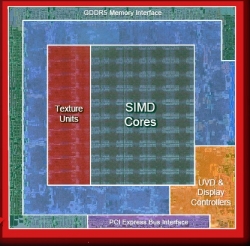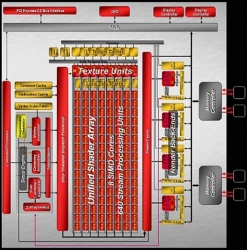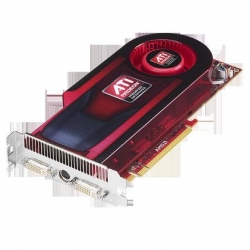Breathing New Life into the ATI 4XXX Lineup:
There is no denying that the 4XXX series cards and specifically the 4870 saved ATI while at the same time giving Nvidia a kick in the gut. The 4XXX cards were released at just the right time to catch Nvidia without the ability to provide immediate competition and also at such a low price point. All that performance came at a price or rather at a temperature. The 4XXX cards ran hot and demanded a lot of power.
Today AMD/ATI seeks to breath new life into the 4XXX lineup with the release of the 4890 and 4770 cards squarely aimed at taking a chuck out of the vast majority of the video card market. Most users, while interested in the ultra high performance cards will end up buying a mid ranged card which impacts their wallet less. It should come as a relief to many consumers then that the new 4890 comes with a price tag of $249 or $229 after MIR (mail in rebate). At this price point you can expect two results:
- ATI will gain further foothold and share in both the high end and mid range markets.
- Nvidia will move to quickly reduce the price of its GTX 280 and new GTX 295 cards.
Both of these reactions are good for you and me as they mean we will be gaming on better equipment at a lower cost. Fans of both Nvidia and ATI should embrace this release as good news, but does the 4890 have what it takes to de-thrown the 280 let alone the monster 295 Nvidia cards and is that even what the 4890 is aimed at?
Our Test Sample:
Our sample used for this review came to us from HIS and is the 4890 Turbo Edition. As you will soon see the default clock rate of the 4890 is 850MHz GPU while our sample came clocked in at 900MHz GPU.
Here are some images:
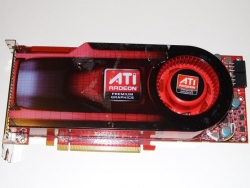 |
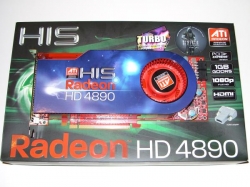 |
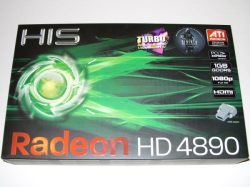 |
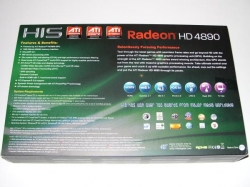 |
 |
 |
Before we dive into the benchmarks we need to take a look at how the new 4890 stacks up against the existing lineup of 4XXX cards. Is the 4890 nothing more than a refresh of an old card with increased clocks or is there more beef under the hood?
Specifications:
The New 4770 in the middle.
| ATI Radeon 4670 | ATI Radeon 4770 | ATI Radeon 4850 | |
| Process |
55nm
|
40nm
|
55nm
|
| Transistors |
514 M
|
826M
|
956M
|
| Engine Clock |
750 MHz
|
750 MHz
|
625 MHz
|
| Stream Processors |
320
|
640
|
800
|
| Compute Performance |
480 GFLOPs
|
960 GFLOPs
|
1.0 TFLOPs
|
| Texture Units |
32
|
32
|
40
|
| Texture Fillrate |
24.0 GTextels/s
|
24.0 GTextels/s
|
25.0 GTextels/s
|
| ROPs |
8
|
16
|
16
|
| Pixel Fillrate |
6.0 GPixels/s
|
12.0 GPixels/s
|
10.0 GPixels/s
|
| Z/Stencil |
32
|
64
|
64
|
| Z Fillrate |
24.0 GSamples/s
|
48.0 GSamples/s
|
40.0 GSamples/s
|
| Memory Type |
GDDR3
|
GDDR5
|
GDDR3
|
| Memory Clock |
1000 MHz
|
800 MHz
|
1000 MHz
|
| Frame Buffer Size |
512MB/1GB
|
512 MB
|
512MB/1GB
|
| Memory Data Rate |
2.0 Gbps
|
3.2 Gbps
|
2.0 Gbps
|
| Memory Bus |
128-bit
|
128-bit
|
256-bit
|
| Memory Bandwidth |
32.0 GB/s
|
51.2 GB/s
|
64.0 GB/s
|
| Maximum Board Power |
59 W
|
80 W
|
110 W
|
ATI places the 4770 to be the next budget card you must have. A quick look at its specifications shows us why. Respectable performance stats at a modest price and low overall power usage. The 4770 is also ATI’s first venture into 40nm territory which is why its heat output is so low given its otherwise lofty specifications.
The new 4890 to the right.
| ATI Radeon 4850 | ATI Radeon 4870 | ATI Radeon 4890 | |
| Process |
55nm
|
55nm
|
55nm
|
| Transistors |
956M
|
956M
|
956M
|
| Engine Clock |
625 MHz
|
750 MHz
|
850 MHz
|
| Stream Processors |
800
|
800
|
800
|
| Compute Performance |
1.0 TFLOPs
|
1.2 TFLOPs
|
1.36 TFLOPs
|
| Texture Units |
40
|
40
|
40
|
| Texture Fillrate |
25.0 GTextels/s
|
30.0 GTextels/s
|
34.0 GTextels/s
|
| ROPs |
16
|
16
|
16
|
| Pixel Fillrate |
10.0 GPixels/s
|
12.0 GPixels/s
|
13.6 GPixels/s
|
| Z/Stencil |
64
|
64
|
64
|
| Z Fillrate |
40.0 GSamples/s
|
48.0 GSamples/s
|
54.4 GSamples/s
|
| Memory Type |
GDDR3
|
GDDR5
|
GDDR5
|
| Memory Clock |
1000 MHz
|
900 MHz
|
975 MHz
|
| Frame Buffer Size |
512MB/1GB
|
512MB/1GB
|
1GB
|
| Memory Data Rate |
2.0 Gbps
|
3.6 Gbps
|
3.9 Gbps
|
| Memory Bus |
256-bit
|
256-bit
|
256-bit
|
| Memory Bandwidth |
64.0 GB/s
|
115.2 GB/s
|
124.8 GB/s
|
| Maximum Board Power |
110 W
|
160 W
|
190 W
|
| Idle Board Power |
30 W
|
90 W
|
60 W
|
From the surface the new 4890 looks like nothing more than an overclocked 4870 and for the most part you would be correct. Peeking beneath the surface we see that ATI has done some fine tuning to the engine that drives the 4890 which is evident by simply looking at the difference between idle board power on the 4870 and 4890. Even though the 4890 runs faster and otherwise has the same specifications, at idle it runs cooler, a whopping 30 Watts cooler!
So Where’s The Beef?
Popping the hood we see that AMD has taken some very specific steps to work on the efficiency of the GPU. The new 4890 is shown below:
Changes to the 4770 of course include a much smaller die based on the 40nm as opposed to the 55nm GPU and is shown below:
Overall we would expect the new 4770 to overclock very well but are unable to report on that aspect of the new 4770 as we do not have a sample of that card in for testing at this time. The new 40nm process and higher GDDR5 memory should post some nice results of course dependant on the speed of the actual memory used on the board.
Test Setup:
AMD 940 X4 Phenom II
MSI Dragon Platform
4GB (2x2GB)Mushkin DDR2 PC8500
Seagate 500GB 7200.11 Hard Drive
HIS ATI 4890
Windows Vista Ultimate SP1 64bit
Gaming and Benchmarks Used:
- 3D Mark Vantage
- Stalker- Clear Sky
- Unigine Tropics
- Left 4 Dead
- Devil May Cry 4
- Crysis Warhead
- Farcry 2
3D Mark Vantage:
|
ATI Radeon 4870
|
HIS Radeon 4890 OC
|
|
| Performance |
10125
|
11005
|
| High |
6536
|
6755
|
| Extreme |
4430
|
4654
|
Stalker- Clear Sky:
|
ATI Radeon 4870
|
HIS Radeon 4890 OC
|
|
| 1024 X 768 |
38.5 fps
|
41.3 fps
|
| 1200 X 1600 |
29.1 fps
|
32.5 fps
|
| 1920 X 1200 |
25.4 fps
|
28.6 fps
|
Unigine Tropics:
|
ATI Radeon 4870
|
HIS Radeon 4890 OC
|
|
| 1024 X 768 8xAA 16x AF |
35.5 fps
|
40.4 fps
|
| 1200 X 1600 8xAA 16x AF |
27.2 fps
|
33.3 fps
|
| 1920 X 1200 8xAA 16x AF |
22.2 fps
|
26.7 fp
|
Left 4 Dead:
|
ATI Radeon 4870
|
HIS Radeon 4890 OC
|
|
| 1024 X 768 8xAA 16x AF |
120.8 fps
|
131.2 fps
|
| 1200 X 1600 8xAA 16x AF |
101.6 fps
|
111.3 fps
|
| 1920 X 1200 8xAA 16x AF |
85.3 fps
|
95.4 fp
|
Devil May Cry 4:
|
ATI Radeon 4870
|
HIS Radeon 4890 OC
|
|
| 1024 X 768 4xAA 8x AF |
95.5 fps
|
98.4 fps
|
| 1200 X 1600 4xAA 8x AF |
77.1 fps
|
81.5 fps
|
| 1920 X 1200 4xAA 8x AF |
62.5 fps
|
68.7 fps
|
Crysis Warhead:
|
ATI Radeon 4870
|
HIS Radeon 4890 OC
|
|
| 1024 X 768 |
34.8 fps
|
41.1 fps
|
| 1200 X 1600 |
26.2 fps
|
31.3 fps
|
| 1920 X 1200 |
23.2 fps
|
28.9 fps
|
Farcry 2:
|
ATI Radeon 4870
|
HIS Radeon 4890 OC
|
|
| 1024 X 768 4xAA 8x AF |
42.5 fps
|
47.3 fps
|
| 1200 X 1600 4xAA 8x AF |
38.9 fps
|
43.0 fps
|
| 1920 X 1200 4xAA 8x AF |
35.0 fps
|
39.5 fps
|
Analysis of Results:
It always amazes me how Crysis can bring a system to its knees. What we see across the board is as expected the ATI 4890 provides a consistent domination over the older 4870. In every case the 4890 comes out ahead and does so by a minimum of 3 to 10 fps. At the street price that AMD expects the 4890 to be selling at the 4890 will be THE card to have if you are an ATI fan.
Cost vs Performance:
The purchasing decision for a 4890 easily comes down to cost vs performance. How much are you getting out of the 4890 vs how much does it cost you. Considering the 4890 is targeted by AMD/ATI towards competing with the Nvidia GTX 260 and not the GTX 280 the choice is rather simple.
As we mentioned earlier the 4890 should hit the streets with a price point about $229 which makes it approximately $30 more expensive than the GTX 260. But for the extra $30 you gain an additional 128MB of memory and performance well over the GTX 260. Lets take a look at the comparison:
For our example we used the same test setup as previously mentioned and substituted the 4890 for the Nvidia BFG GTX 260 which we picked up locally at Best Buy. We ran four of the same benchmarks utilizing the GTX 260 on a clean installation.
Test Setup:
AMD 940 X4 Phenom II
MSI Dragon Platform
4GB (2x2GB)Mushkin DDR2 PC8500
Seagate 500GB 7200.11 Hard Drive
HIS ATI 4890
Windows Vista Ultimate SP1 64bit
Comparison Gaming and Benchmarks Used:
- 3D Mark Vantage
- Stalker- Clear Sky
- Left 4 Dead
- Crysis Warhead
3D Mark Vantage:
|
BFG Nvidia GTX 260
|
HIS Radeon 4890 OC
|
|
| Performance |
9104
|
11005
|
| High |
6443
|
6755
|
| Extreme |
4220
|
4654
|
| Superior Score | Inferior Score |
Stalker- Clear Sky:
|
BFG Nvidia GTX 260
|
HIS Radeon 4890 OC
|
|
| 1024 X 768 |
31.5 fps
|
41.3 fps
|
| 1200 X 1600 |
23.3 fps
|
32.5 fps
|
| 1920 X 1200 |
19.4 fps
|
28.6 fps
|
| Superior Score | Inferior Score |
Left 4 Dead:
|
BFG Nvidia GTX 260
|
HIS Radeon 4890 OC
|
|
| 1024 X 768 8xAA 16x AF |
99.4 fps
|
131.2 fps
|
| 1200 X 1600 8xAA 16x AF |
85.6 fps
|
111.3 fps
|
| 1920 X 1200 8xAA 16x AF |
75.8 fps
|
95.4 fps
|
| Superior Score | Inferior Score |
Crysis Warhead:
|
BFG Nvidia GTX 260
|
HIS Radeon 4890 OC
|
|
| 1024 X 768 |
37.9 fps
|
41.1 fps
|
| 1200 X 1600 |
31.7 fps
|
33.3 fps
|
| 1920 X 1200 |
27.3 fps
|
28.9 fps
|
| Superior Score | Inferior Score |
As you can see the GTX 260 gets owned by the 4890 in each of our tests. As for the cost vs performance:
|
HIS ATI Radeon 4890
|
BFG Nvidia GTX 260
|
|
| Performance Per Dollar$ * |
5.93 GFLOPs/$
|
3.59 GFLOPs/$
|
| Performance Per Watt (at Maximum Power) ** |
7.15 GFLOPs/Watt
|
3.92 GFLOPS/Watt
|
* The HIS Radeon has a Compute Power of 1.36 TFLOPs. The GTX 260 Has a Compute Power of 715 GFLOPs.
** The 4890 is rated for a maximum power consumption of 190W. The GTX 260 is rated for a maximum power consumption of 182W.
When put into perspective we can see why the 4890 is a better choice than the GTX 260 for its lower power consumption vs performance and overall greater performance per dollar spent.
Analysis and Conclusion:
There is no doubt that the 4890 is an excellent product especially considering the price. What worries us is that ATI is spending the time to revamp an older product line rather investing into the 5XXX series cards. It very well could be that the 4890 represents aspects we will see in later products such as greater efficiency and lower costs. You can bet the new cards will be based on the 40nm process that we see being used in the 4770 and smaller die means lower cost for the consumer as ATI will be able to crank out more of these per wafer.
For a street price of $229 you really cant go wrong with the 4890. It becomes a red hot deal when you throw in the natural ability for the 4890 to overclock like mad and remain stable. Considering the performance, cost, and overclockability of the this product, the 4890 earns the coveted Awesome Hardware Award.
